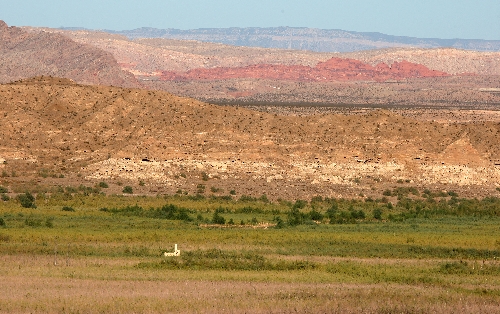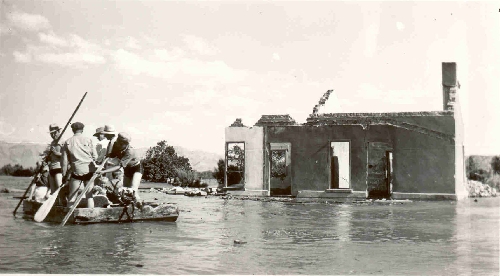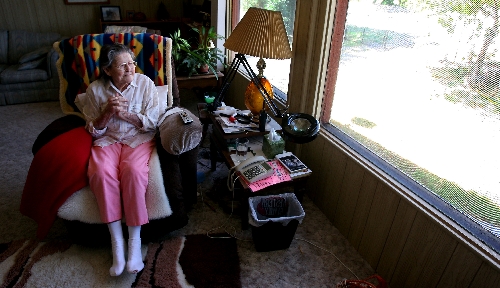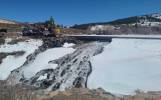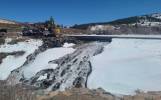St. Thomas residents knew progress doomed their town
It launched a new era that would completely transform the Southwest, but the dedication of Hoover Dam didn't change what was about to happen to St. Thomas.
The fate of the Moapa Valley town was decided almost a decade before. Its residents already knew their community was headed for a watery grave.
"I used to have nightmares about it. In my mind, the water would come up in a wave," said Verna Heller. "It really worried me."
Heller was 13 years old when the federal government bought her family's house and small farm in St. Thomas in 1932. Six years later, her hometown was swallowed by the rising waters of the nation's largest man-made reservoir.
Now 91, Heller still lives in the Moapa Valley and still recalls St. Thomas fondly.
It was the sort of place where people shared farming equipment and helped each other work the fields.
"It was like one big happy family," she said. "It was a darned good place to live."
The community was founded by Mormon settlers sent by Brigham Young to colonize the Moapa Valley in 1865.
By the end of 1866, church records show 45 families growing cotton and other crops near the confluence of the Muddy and Virgin rivers.
In an article called "The Mormon Atlantis," Nevada historian Dennis McBride describes the harsh conditions in early St. Thomas, where "grasshoppers plagued the fields" and settlers died from heat and mosquito-borne diseases.
Ultimately, though, it was a boundary dispute that doomed the initial settlement.
As McBride explains, Nevada, Utah and Arizona all laid claim to the Moapa Valley. When an 1870 survey put the area squarely in Nevada, the settlers decided, with Young's blessing, to abandon the area rather than pay taxes to what then was Lincoln County.
But new Mormon settlers drifted into the Moapa Valley in 1880, and St. Thomas began to flourish.
At its peak in the early 20th century, the town and surrounding area were home to about 2,000 people.
The town had no police, jail or town government, but it did have a 14-room hotel, several stores and a soda fountain.
Heller said the two-story brick schoolhouse doubled as the Mormon church and community center.
The farmers there grew a wide variety of crops, including peaches, melons, grapes, figs, wheat, barley, corn, almonds and asparagus.
In 1912, the San Pedro, Los Angeles & Salt Lake Railroad built a spur to St. Thomas to haul produce from local farms and ore from the gold and copper mines in the surrounding hills.
Heller's parents moved to St. Thomas from central Utah in 1917 in search of a better school for their children.
She was born Verna Chadburn on Feb. 24, 1919. Her mother had to ride in a wagon more than 60 miles to St. George, Utah, to give birth to her because St. Thomas didn't have a doctor.
Heller had a twin brother, Vaughn, but he died when he was 3 months old, leaving her as the youngest of 10 kids.
They shared a two-story wooden house with "trees all around it and roses climbing up the front," she said.
Her father cultivated grains and hay for their cows, chickens and other animals. They also kept seasonal gardens and canned their own fruit.
Summers were long and brutal in the lower Moapa Valley, and Heller said the family used to sleep outside for "months and months of the year."
"It was so unbelievably hot, I remember that. The only way we could cool off was to get into (an irrigation) ditch," she said.
The community's first hint of real trouble came in 1920, with the arrival of scouting teams from the federal Bureau of Reclamation.
One of the first teams to come to St. Thomas set up camp on the Chadburns' farm. Heller remembers one of the surveyors in particular: Walker Young, who would go on to serve as the bureau's construction engineer for Hoover Dam.
The fate of St. Thomas was officially sealed in 1928, when Congress approved the dam as part of the Boulder Canyon Project Act. President Herbert Hoover signed the appropriation the following year.
By the time Franklin D. Roosevelt delivered his dedication speech on Sept. 30, 1935, Lake Mead already had begun to fill.
"At the time you hated it, but it was probably the best thing that could have happened," Heller said.
As pastoral and tight-knit as St. Thomas was, many people there were barely scraping by, she said.
The dam brought jobs and some prosperity to the region, both during and after construction. Heller had a brother and brother-in-law who found work on the project.
If St. Thomas hadn't been flooded, "we all would have starved," she said, only half joking. "We didn't know how poor we were."
Heller doesn't recall her parents expressing any sadness or anger about the town's fate, though they were "a little upset" about the price the government paid them for their property.
Apparently they weren't alone.
McBride writes that the average offer of about $40 an acre did not sit well with many St. Thomas residents, but they had little choice in the matter.
By the summer of 1932, the government owned the entire town, and the lower end of the Moapa Valley gradually began to empty out.
The Chadburn family left that year for Springville, Utah, near Provo. Someone bought the house they left behind and moved it up the valley to Overton, where it eventually burned to the ground.
In 1933, the St. Thomas school closed for good after an academic year that began with 35 students and ended with 15.
About that same time, the town cemetery was relocated to a bluff overlooking the Muddy River south of Overton, a delicate operation that included moving the bodies of Heller's twin brother, baby sister and grandmother.
The Chadburns weren't around for that, but they did move back to the Moapa Valley in 1936, settling in Logandale just in time for Heller's junior year of high school.
She was married with a child on the way by the time the new reservoir began to close in on St. Thomas in 1938.
Before the water got there, most of the buildings were knocked down, dismantled or moved. The orchards and many of the large shade trees were cut down so they wouldn't snag boats from the bottom of the lake.
The last resident to leave was Hugh Lord, who ran a garage in town.
Lord waited until the water was high enough for him to step out his front door into his boat. Then he set fire to his house and watched it burn.
St. Thomas officially ceased to exist on June 11, 1938, when the post office closed for good.
McBride describes one popular version of what happened that day: "Leland Whitmore, the St. Thomas postmaster, canceled 4,000 letters as Lake Mead's rising waters lapped at the foundation of the post office. At four o'clock that afternoon, Whitmore threw his stamp canceler as far out into the water as he could, and workmen demolished the building."
Most of the letters in Whitmore's mail bag as he left St. Thomas came from collectors seeking that rarest of keepsakes: a last-day cancellation from the day an entire town died.
Several different commemorative envelopes were made for the occasion, including one -- now part of the collection at the Nevada State Museum in Las Vegas -- that read: "Boulder Dam waters sounds 'Taps' for the town of St. Thomas, Nevada." That particular letter was mailed to an address in Seminole, Okla., with a special, 3-cent Boulder Dam postage stamp.
Heller said she and her husband drove down from Logandale regularly to watch it all unfold.
Near the end, she said, they made the trip to St. Thomas almost every day to walk barefoot in the mud and paddle around in the rising water.
Her nightmares were wrong. The water came up fast, but it did not arrive in a wave, she said.
They watched in wonder as the lake crept up the trunks of trees and washed into people's yards.
When it poured into the cisterns where residents used to store their drinking water, the displaced air set off watery eruptions "just like a geyser coming up," Heller said.
They would return to the town site several times over the years, when the reservoir dropped low enough to reveal it again.
"I can walk up and down the streets and know just where I am," she said.
On one of her visits back to the muddy ruins of her hometown, Heller found a $5 gold piece in a spot where stranded travelers used to crouch in the shade of pomegranate trees and gamble while they waited for their wagons to be fixed.
"There that thing was looking up at me all bright and shiny," she said.
The ruins re-emerged at least nine times between 1938 and 1972. In 1952 and 1965, the site dried out enough for St. Thomas residents to hold reunions there.
The town remained deep underwater from 1972 until 2002, when the current drought took hold on the Colorado River.
Today, the ruins of St. Thomas are partially hidden in what looks like a dry valley choked with brush.
Lake Mead is nowhere in sight.
Contact reporter Henry Brean at hbrean
@reviewjournal.com or 702-383-0350.
HOOVER DAM
75th Anniversary
INTERACTIVE
VIDEOS
SLIDE SHOWS



